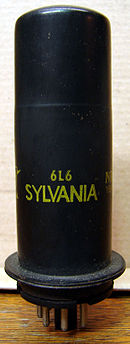6L6
The 6L6 (Russian type designation 6П3C ) is an electron tube that is designed as a beam pentode or beam power tetrode . It was developed in 1936 as a steel tube with a standard octal socket by the Radio Corporation of America (RCA).
The Dutch company Philips held a patent on pentodes at the time . In order to bypass the patent license, English tube engineers developed the beam tetrode as early as 1933 and later sold the development to the American electronics manufacturer RCA. This tube also has five electrodes in the electrode system, the function of which basically corresponds to that in a pentode, but in order to circumvent the pentode patent, the manufacturer called it a tetrode.
With the Beam-Power-Tetrode, the pentode-typical retardation grid is replaced by specially shaped electron baffles, which concentrate the electron flow from the cathode to the anode and, through a space-charge effect, have a similar effect on the undesired emission of secondary electrons from the anode as the usual retardation grid of a pentode. The wires of the control grid and screen grid, wound with the same pitch, lie exactly one above the other. Both measures represent an electron-optical system that gives the tubes better properties than conventional pentodes (less distortion, less feedback from the anode on the control grid).
Characteristics
use
The 6L6 is mainly used today in the construction of tube amplifiers for electric guitars . It is used in the final stage. The "classic" 6L6 amplifiers are models from Fender , e.g. B. the " Fender Bassman " or the "Fender Twin Reverb". The sound of various amplifier models from Mesa / Boogie is also based on these tubes, e.g. B. the "Mark IV", while other established amplifier manufacturers rely on other tube types in the power amplifier for the "sound" of their models ( Marshall : EL34 , Vox : EL84 ).
Web links
- Data sheet of the RCA for the 6L6 (PDF; 255 kB)
Individual evidence
- ↑ '59 Bassman on www.fender.com ( Memento from December 20, 2008 in the Internet Archive )
- ↑ '65 Twin Reverb on www.fender.com ( Memento from December 20, 2008 in the Internet Archive )
- ↑ Mark IV. (PDF) Owner's Manual. Retrieved January 4, 2016 .



